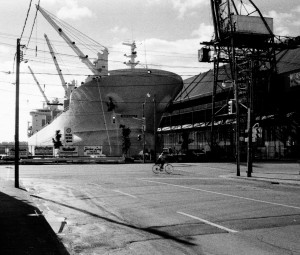Watching and Waiting?
The connection is “signalised junctions”. Although the one above from the quayside in Toronto (Queens Quay East/Lower Jarvis Street in October 2002) is a three-arm junction, the ship seems poised to pass through the junction from a virtual fourth-arm. It also seems to be watching the cyclist!
Although there’s an obvious difference between the size of the ship and bike, the image also shows the amount of space that’s been provided for highway use and yet there’s only a bike using it. The width of the road is based on the amount of space “needed” for peak-time traffic, which for long periods of the day is largely redundant. You could argue that such road space is also redundant during peak-times, because car drivers often take three empty seats with them. Urban transportation systems based on bicycles are far more efficient and much less space-hungry.
The image also shows the distances that pedestrians have to cross, which must be intimidating if there are cars and lorries using the junction. Having said that, “jaywalking” laws in Canada stop people from crossing roads when the “walk” signals aren’t shown, which means that crossing should be safe. The by-product of such limited crossing opportunities is community severance, reducing pedestrian interactions between each side of the street.
Jaywalking laws have been in force for decades in Canada and the USA and originate from the early days of motoring when the death toll due to collisions between people and cars was horrendous. The laws were invented by the car industry in order to shift the blame for vehicle collisions onto victims, at the same time claiming the streets for cars and effectively changing the traditional use of streets as places for people. The car was seen as an unwelcome guest in the street and some localities erected war memorial type monuments to commemorate child pedestrian traffic deaths. Perhaps this idea should be revisited for modern use instead of the temporary floral tributes that are all too commonly seen. Could it improve driving?
Sorry, I’ve managed to go from a simple walkabout with a camera in a non-touristy part of Toronto, which at the time I thought would be interesting, to a small rant about the state of “modern” transport infrastructure. There, I’ve done it again, I just wouldn’t let it lie, I’ve placed quotes around the word modern to suggest some dissatisfaction etc………….

